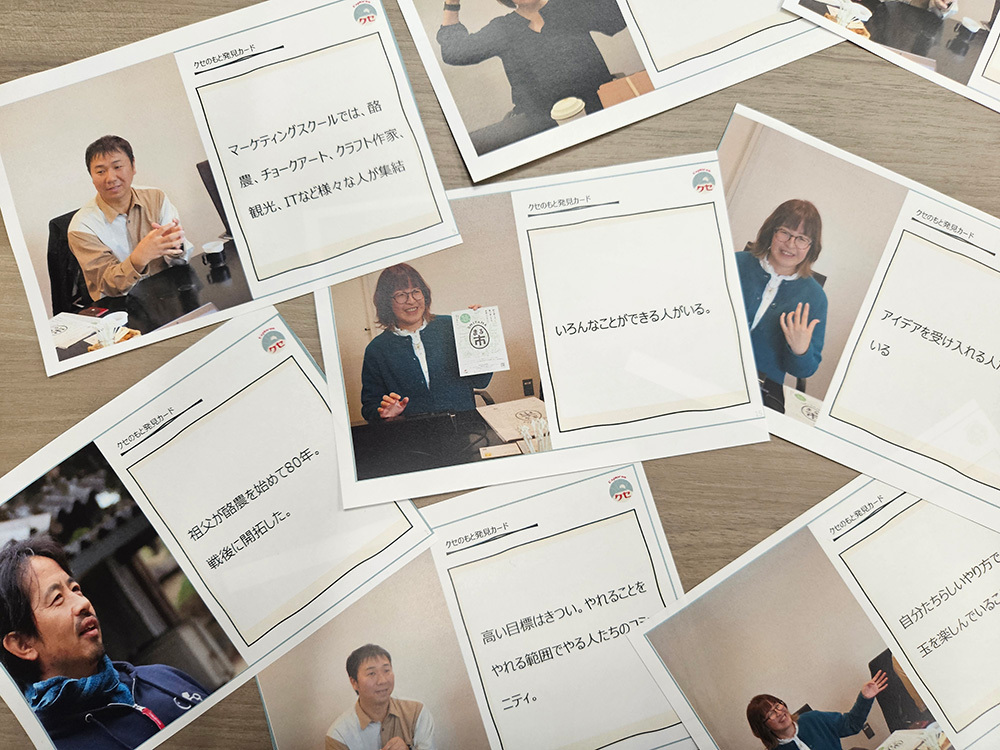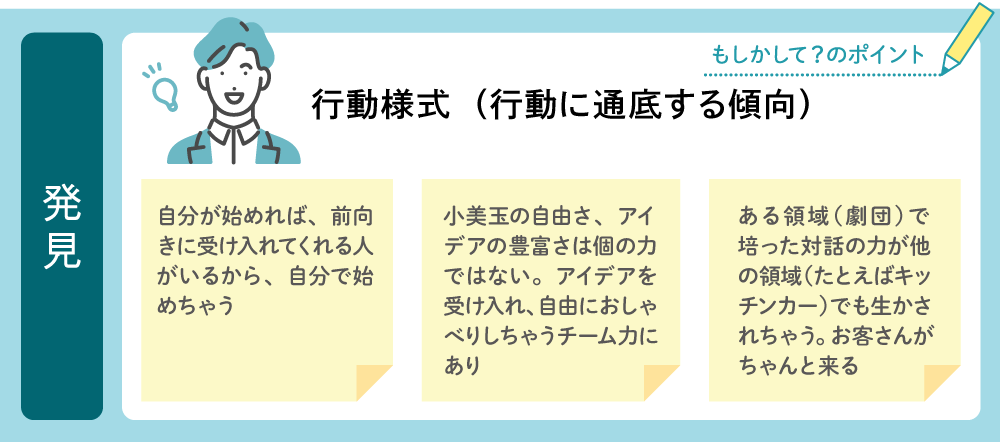This series features three planners from Dentsu Inc., experienced in numerous regional revitalization initiatives, proposing the concept of 'Regional Quirks' as a new approach.
*"Regional Quirks" refers to the "unconscious behavioral patterns" underlying a region. By revealing these "quirks" present in the background of everything—regional industries, tourism, local specialties—the aim is to foster sustainable economic zones across Japan. For details, see Parts 1 and 2!
Last time, we visited Omitama City in Ibaraki Prefecture. As a preparatory step for discovering quirks, we conducted a "Quirk Exploration" where we interviewed "non-conformist players" active in Omitama. This time, we propose a workshop to organize the collected "quirk seeds" and clarify the region's quirks.
Presented by three "quirky characters": Toshiaki Morio from 47CLUB Inc., Takuya Kagata from the Global Business Center, and Nobu Miyazaki from Dentsu Inc. Business Transformation Creative Center.
The statements themselves are quirks! Explore regional quirks using "Quirk Origin Cards"!
Kagata: Last time, the three of us collected about 100 "habit seeds" from Omitama City, Ibaraki Prefecture, and turned them into cards. This time, we developed and conducted a workshop to reveal the unconscious behavioral patterns—the "habits"—of Omitama residents by arranging and examining these "habit seed cards." We'll share key points for discovering "habits" from the "habit seed cards" so readers can replicate this process!
Morio: Quirks often show up in the actual statements made during interviews, right? We wanted to explore that further. However, a pleasant surprise this time was that Komiyama City residents were quite self-aware about their strengths—their "Komiyama City quirks," so to speak—and could articulate them quite well. While the workshop aims to uncover unconscious behavioral patterns, we found many were conscious patterns.
Kagata: I think how aware people are of their quirks varies greatly between municipalities. So, please keep in mind that "Komiyama is a bit of a rare case" as you read this (laughs). You could say, from a regional revitalization perspective, it's an "ideal" town.
Miyazaki: The workshop proceeds with the "Habit Discovery Worksheet" introduced in the third installment at hand. That said, each region has its own distinct character. Interview subjects can be maverick challengers, and unexpected events frequently occur.
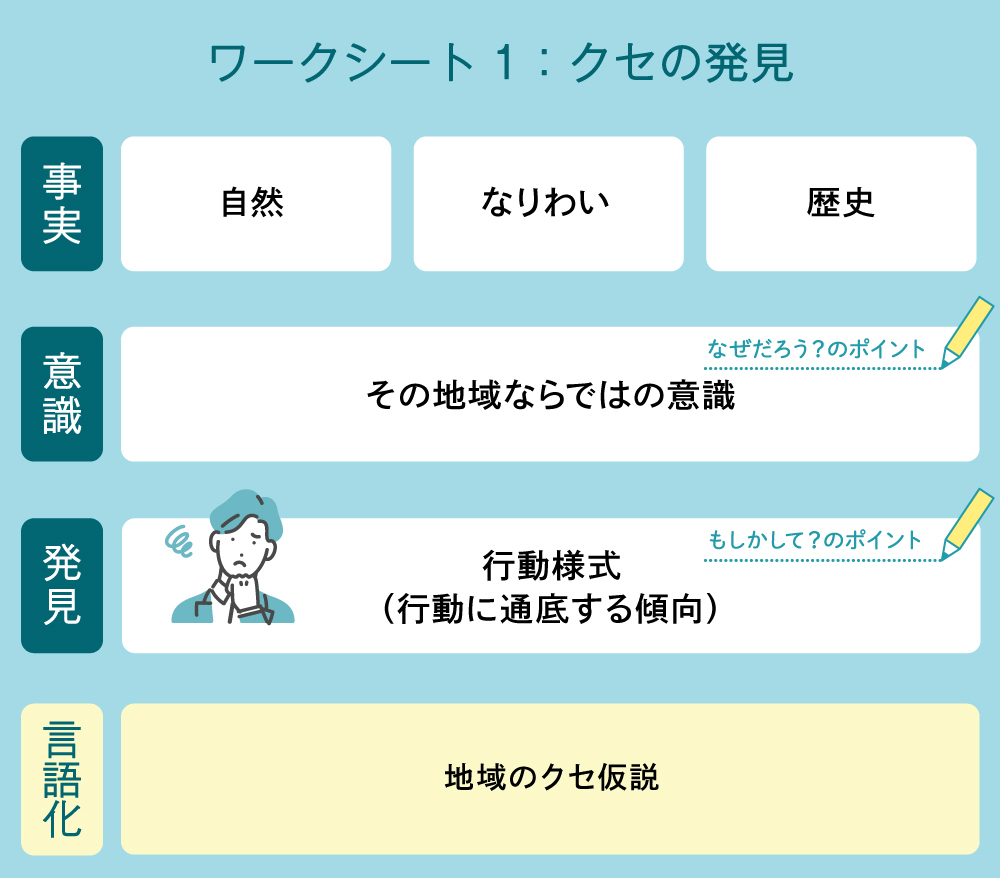
Within this series, the worksheet content may be updated based on experiences in various regions. Please refer to the latest article version as a rule.
Morio: This worksheet is essentially a framework to organize quirks and make them easier to consider. When conducting the "Quirk Discovery Workshop," we envision using large flip charts or similar surfaces where everyone writes the "contents" on sticky notes and posts them together.
Kagata: Simply put, it's designed to make the "process of identifying local quirks" something you can do while chatting and brainstorming with the local community.
Morio: That said, we don't expect everyone's comments to neatly fit into this framework. Many people will go beyond it, or even dislike the framework itself. I sometimes think that actually shows the strength of the local players. Our intention is the opposite—we see it as a tool to help us listen without preconceptions and engage in lively discussions.
Kagata: Exactly. Anyway, this time, using Omitama City as our case study, let's go through the entire workshop process together, the three of us!
■ Habit Discovery Workshop / Overall Worksheet Overview
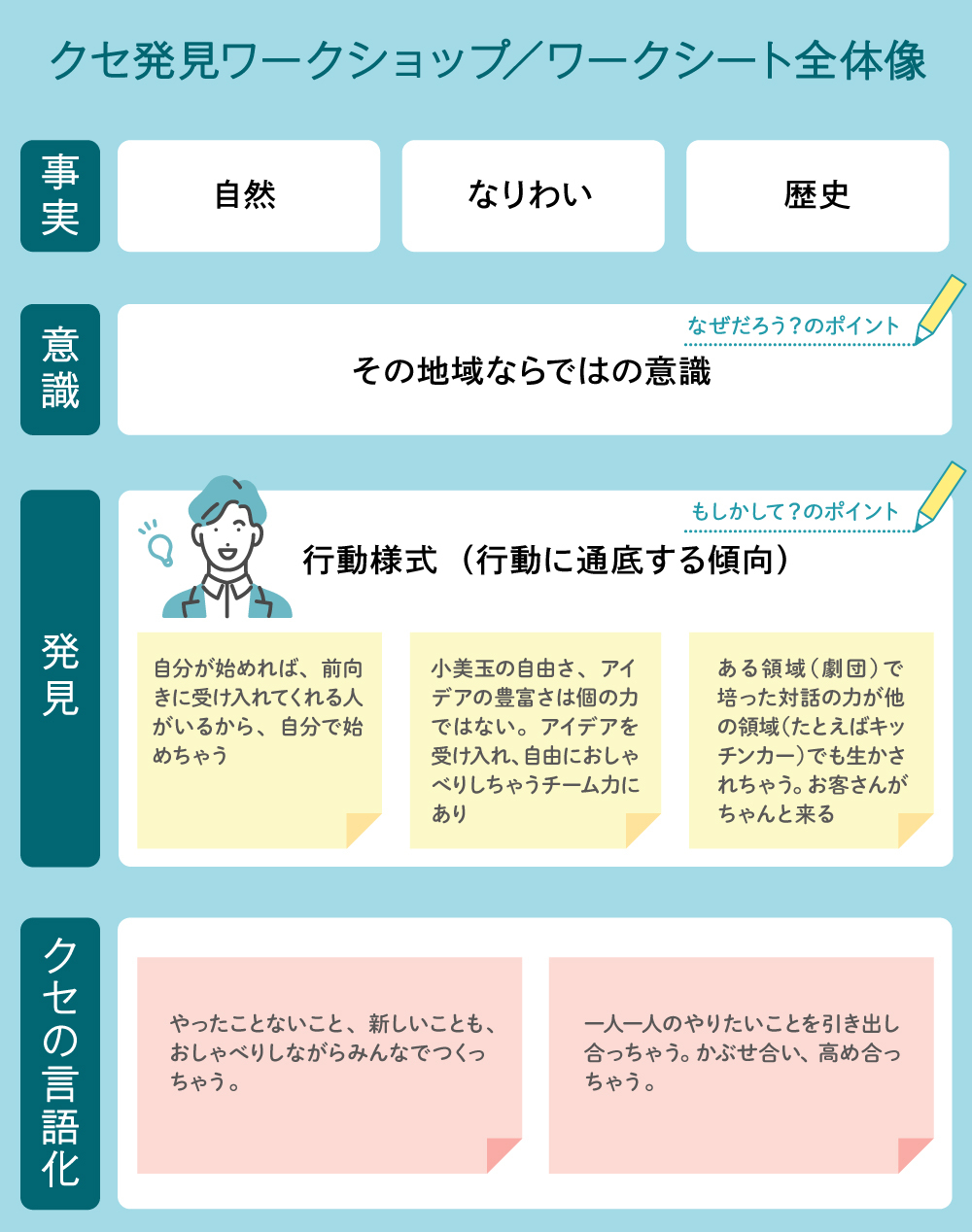
① Analysis Phase: Plot representative "facts" and "awareness" onto the worksheet from the habit root cards collected (around 100, see previous session).
② Discovery Phase: Then, in the "Discovery" column, write down the unique behavioral patterns specific to that area that emerged from the "facts" and "awareness," and attach sticky notes.
③ Verbalization Phase: Finally, synthesize the content of the "Discovery" sticky notes and verbalize them as "habits." Step 1-a: Pick up the region's "specific facts (reasons the quirks emerged)"
Kagata: First, arrange the collected cards while discussing which parts of the worksheet they correspond to.
Morio: For a relatively simple workshop introduction, it's better to plot concrete factual content into the "Nature," "Livelihood," and "History" areas rather than abstract behavioral patterns or ways of thinking. The key point is that if local residents participate in the workshop, it's good if they experience a sense of surprise, like "Oh, our region has this too."
Miyazaki: Where do these shared local quirks come from? They stem from the "nature" shared by people living in the same area – climate, landscape, topography, geology – the "livelihoods" that have evolved and been sustained locally from these natural resources up to the present day, and the "history" the region has experienced, including external factors like politics and economics. Since these are mostly fact-based elements, categorizing them into cards should be relatively straightforward. When these connect to what we might call regional quirks, you can discover that "Ah, I see!" moment of interest within the context.
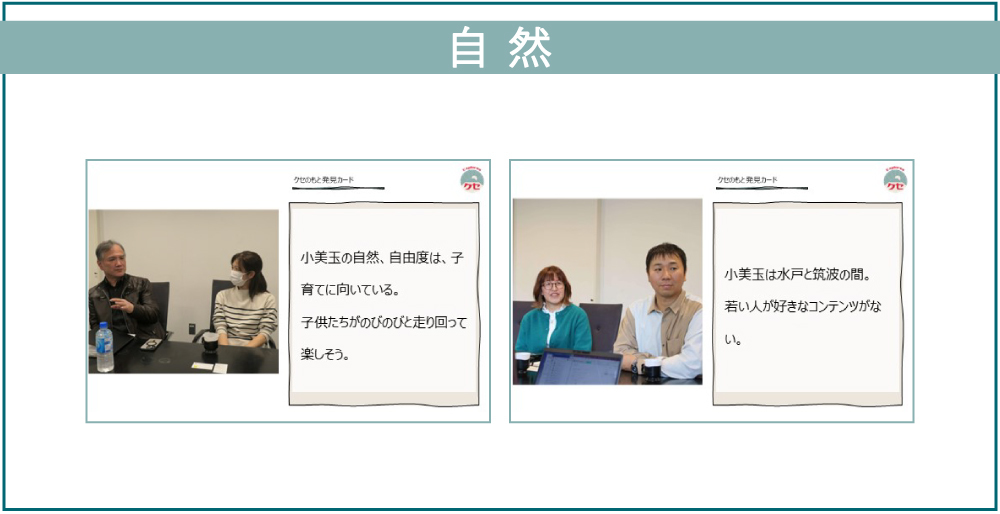
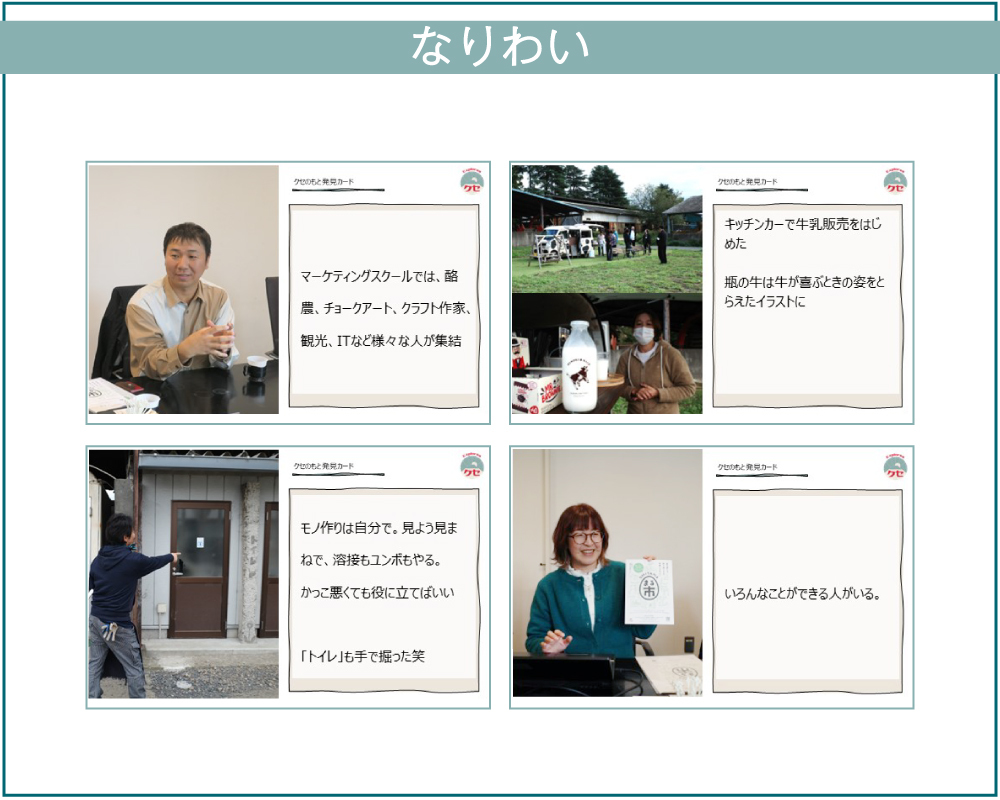
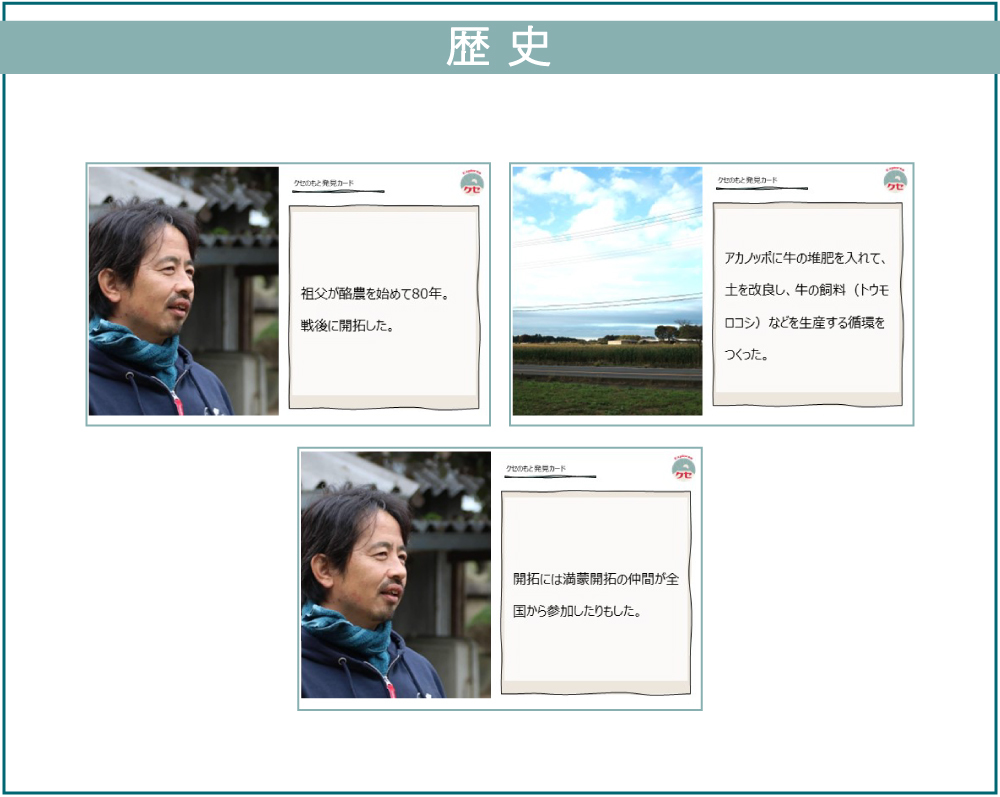
Kagata: By the way, a note about the format for the "Quirk Origin Cards." Since this is a pseudo-workshop, we've standardized the format for the article, but you don't have to force a combination with photos. Also, the three categories don't need to be taken too rigidly. Even in this pseudo-workshop, we're classifying and plotting quite casually (laughs).
Morio: The goal is to bring out "quirks" from various angles, so prioritizing "following the format" above all else defeats the purpose. Think of the worksheet as just a rough guide.
Miyazaki: Cards describing ways of thinking or behavioral characteristics that don't fit into any of "Nature," "Livelihood," or "History"— —will be placed in the next "Consciousness" frame.
Step 1-b: "That's how they think?!" Extract several types of "unique regional consciousness"
Kagata: Anything that doesn't fit into the three categories of the "Facts" phase should be placed in the "Mindset" area for now. Classify various scenes and memorable statements from locals into "clusters" that seem to share common threads. Try to aim for creating at least five distinct clusters.
Morio: A tip for categorizing: think of it less as separating statements and more as gathering them. Collect cards like "This person's statement connects with that person's statement" into one "cluster." Include cards describing actions too. As you discuss and place cards, you'll likely see "Ah, so that's the context they're thinking in!" revealing "unconscious behavioral patterns."
Miyazaki: At this stage, it's perfectly fine if the same card ends up in more than one cluster. If you find a card that fits both, try placing it between the two clusters. The real reward of this process lies in observing the relationships between clusters—their causal connections and other patterns. Gradually, the region's unique "unconscious behavioral patterns" will start to emerge.
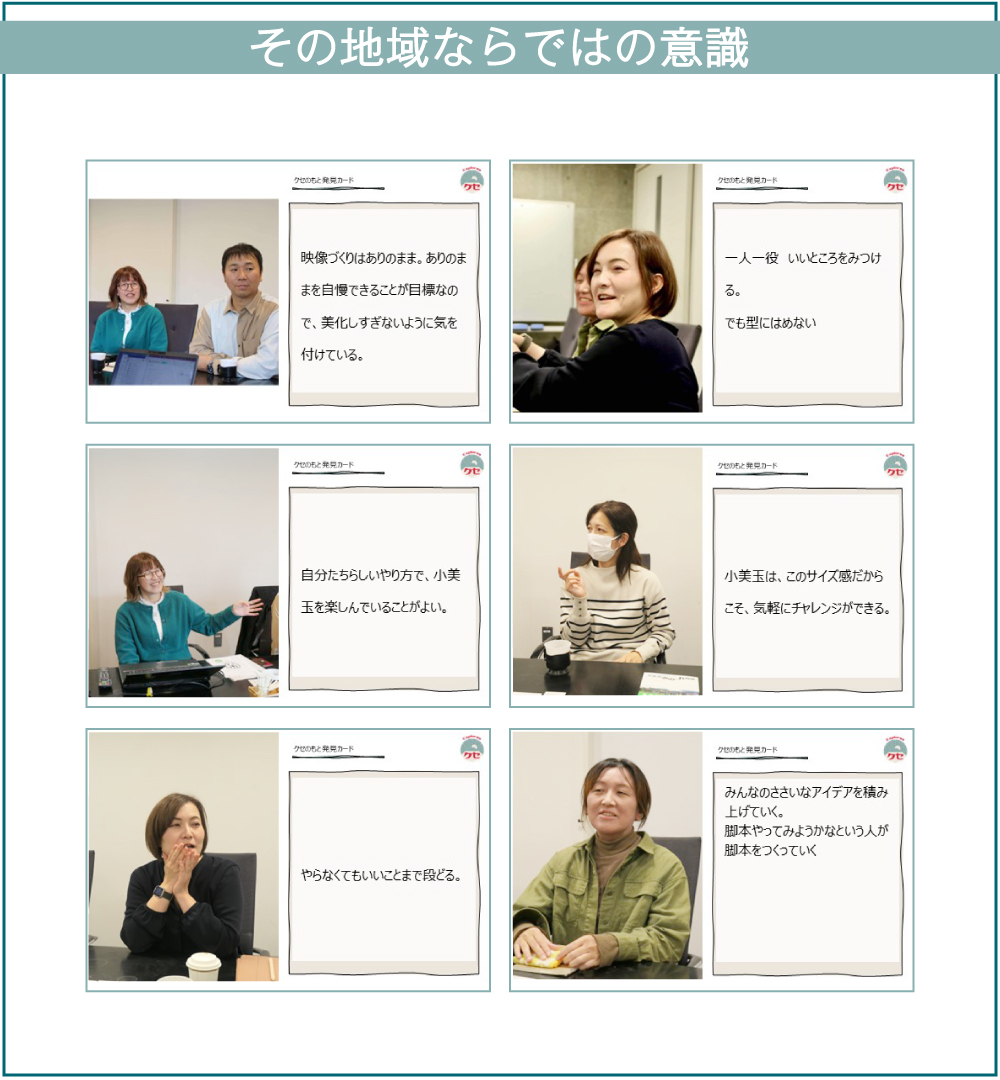
The group discussing "being able to do what each person wants to do"

The cluster discussing "dialogue and how we interact with each other"
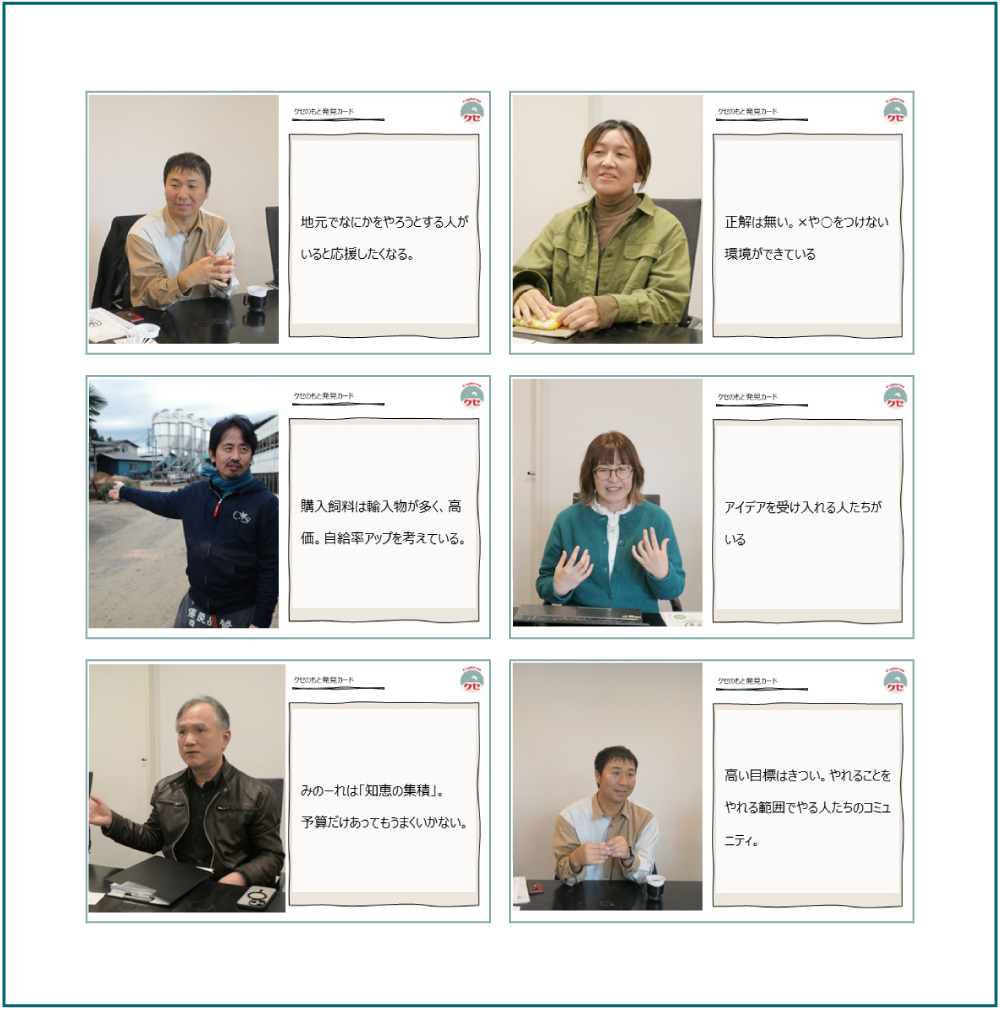
A group discussing "Let's do everything ourselves" and "Let's support those who do things themselves"
Morio: By the way, whether the "conscious/unconscious" classification works depends entirely on the quality of the "Habit Origin Cards" themselves. The key is the facilitation technique for "element extraction" mentioned in the previous article. The words that emerge during interviews are chosen by the local players themselves, so they're already packed with habit origins at that point.
When interviewing participants, it's crucial to ask how their statements connect to "what positive outcomes" or "what characteristics," and further, "what behavioral patterns those characteristics consolidate into," and to record this on the Habit Origin Cards.
Miyazaki: So, once we hear "words describing the region," we don't stop there. By further asking about "the background" and such, the content on the cards deepens, right?
Kagata: Putting it that way might sound challenging for those new to interviewing. But even just taking one step deeper during the interview—like asking, "For example, how might that connect to something positive?"—can significantly improve the quality of your cards.
Morio: Essentially, these delved-into "elements" often reveal more concrete or abstract dimensions than the initial statement, showing various expanses. These expanses connect the words, revealing patterns or recurring themes like threads.
Miyazaki: What's interesting is that when you lay out the cards and discuss them together, you start to see "connections" between the cards that weren't apparent in the "words" during the interview. That's why, even if you couldn't articulate it well during the interview, it's good to keep statements that made you think "Hmm, that's interesting" or "That caught my attention" on a card.
Morio: By the way, revisiting why we specifically create these "root habit cards" – it's to prevent the workshop from becoming one where we have preconceived notions or predetermined answers. By putting them on cards, the local residents' statements are properly preserved, and when we're thinking, we can always return to the root statements.
Miyazaki: So, to verify if each element is truly a "local quirk," it's important that "multiple people are saying or doing similar things," right?
Morio: Exactly. To summarize, if you use this worksheet framework as a reference, you can grasp the shared sense of what should be considered a "habit" within the region. By listing characteristic "actions" of the area, or even more abstract "behavioral patterns," and looking at them holistically ( ), if you can find common elements, then perhaps that is the "regional habit."
Step 2: Behavioral Patterns Revealed Through Overview
Kagata: The groundwork is now complete, and here comes the fun part (laughs). Using the cards we've laid out so far, we extract the behaviors that people in that region unconsciously exhibit. We formulate hypotheses like, "Could this be a quirk?" and categorize them into several patterns.
Morio: In this phase, whenever you think, "This might be a habit," jot it down on a larger sticky note (like a Post-it) and stick it onto the "Discoveries" section. This time, the three of us examined the "Facts" and "Awareness" cards and naturally extracted three distinct "behavioral patterns."
Miyazaki: The key criterion for identifying potential habits at this stage is whether it involves "I just can't help but do ◯◯." For example:
Miyazaki: In this series, we defined habits as "unconscious behavioral patterns." If you find common things among what local people say or do—things like, "No one told us to, but come to think of it, we all just end up doing this"—then it's highly likely that's a local habit.
Morio: So, during discussions around the worksheet, if local people get excited with comments like "Yeah, that's right! We all just end up doing that," it increases the likelihood that it's a "habit."
Miyazaki: However, it's perfectly fine if we don't pinpoint just one "habit" at this stage. As the saying goes, "Every man has his quirks," and it's only natural to have several habits (laughs). Let's keep it at the "hypothesis" level and brainstorm a few possibilities.
Step 3: Articulating the "Local Quirk" (A Twist for Building Empathy)
Kagata: Finally, the last step: articulating the "local quirks." In the previous step, you likely identified several "quirk hypotheses" – unique behavioral tendencies specific to the area that you thought might be quirks. Now, we'll consolidate these into one or two core quirks.
Miyazaki: We'll examine whether the "habit hypotheses" written on Post-its in the previous step can be consolidated. A useful approach is to discuss them verbally, asking questions like: "What do these hypotheses have in common?" or "What happens because of this habit?"
Morio: As mentioned several times in this series, the ideal concept of a regional quirk is something that "can foster positive actions for the future." In a sense, we aim to distill it into words that could become the region's catchphrase or serve as a guiding principle for action. At this stage, it might be beneficial to have members skilled in copywriting or crafting concepts and visions participate.
Kagata: After discussing our "habit hypotheses" as a trio, we concluded these two might be "Omitama's habits":
Miyazaki: You've aligned the hypotheses and distilled them into behavioral patterns like "can't help but ◯◯." Sometimes, traits we initially aimed to consolidate into one category end up splitting into two. But as I mentioned earlier, "everyone has their quirks," so there's no need to force them into a single category. Even in the "using the quirks" phase later on, we'll likely see cases where two or more quirks are used appropriately.
Morio: That wraps up the workshop for now! However, as mentioned earlier, Omitama is a somewhat special case where many "habits" were already apparent during the initial interviews. Still, we designed this process to enable discovering "habits" in other regions using essentially the same steps.
Kagata: Of course, the concept of "regional quirks" is still new, and we're feeling our way forward. We plan to continuously refine and update both the workshop steps and the interview sheet format going forward. If anyone is interested in "trying out a workshop together," please feel free to consult with the three of us!
Next time, we'll introduce what could be considered the climax of this series: "How to Use the Discovered Quirks?"
<Summary of This Session>
1.Realizing that sometimes two habit ideas come up
2."I just can't help but..." is the key phrase for discovering habits





